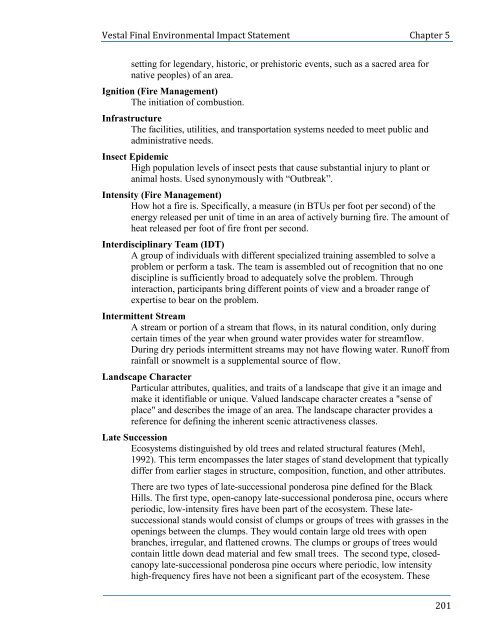Final Environmental Impact Statement
Final Environmental Impact Statement
Final Environmental Impact Statement
Create successful ePaper yourself
Turn your PDF publications into a flip-book with our unique Google optimized e-Paper software.
Vestal <strong>Final</strong> <strong>Environmental</strong> <strong>Impact</strong> <strong>Statement</strong> Chapter 5<br />
setting for legendary, historic, or prehistoric events, such as a sacred area for<br />
native peoples) of an area.<br />
Ignition (Fire Management)<br />
The initiation of combustion.<br />
Infrastructure<br />
The facilities, utilities, and transportation systems needed to meet public and<br />
administrative needs.<br />
Insect Epidemic<br />
High population levels of insect pests that cause substantial injury to plant or<br />
animal hosts. Used synonymously with “Outbreak”.<br />
Intensity (Fire Management)<br />
How hot a fire is. Specifically, a measure (in BTUs per foot per second) of the<br />
energy released per unit of time in an area of actively burning fire. The amount of<br />
heat released per foot of fire front per second.<br />
Interdisciplinary Team (IDT)<br />
A group of individuals with different specialized training assembled to solve a<br />
problem or perform a task. The team is assembled out of recognition that no one<br />
discipline is sufficiently broad to adequately solve the problem. Through<br />
interaction, participants bring different points of view and a broader range of<br />
expertise to bear on the problem.<br />
Intermittent Stream<br />
A stream or portion of a stream that flows, in its natural condition, only during<br />
certain times of the year when ground water provides water for streamflow.<br />
During dry periods intermittent streams may not have flowing water. Runoff from<br />
rainfall or snowmelt is a supplemental source of flow.<br />
Landscape Character<br />
Particular attributes, qualities, and traits of a landscape that give it an image and<br />
make it identifiable or unique. Valued landscape character creates a "sense of<br />
place" and describes the image of an area. The landscape character provides a<br />
reference for defining the inherent scenic attractiveness classes.<br />
Late Succession<br />
Ecosystems distinguished by old trees and related structural features (Mehl,<br />
1992). This term encompasses the later stages of stand development that typically<br />
differ from earlier stages in structure, composition, function, and other attributes.<br />
There are two types of late-successional ponderosa pine defined for the Black<br />
Hills. The first type, open-canopy late-successional ponderosa pine, occurs where<br />
periodic, low-intensity fires have been part of the ecosystem. These latesuccessional<br />
stands would consist of clumps or groups of trees with grasses in the<br />
openings between the clumps. They would contain large old trees with open<br />
branches, irregular, and flattened crowns. The clumps or groups of trees would<br />
contain little down dead material and few small trees. The second type, closedcanopy<br />
late-successional ponderosa pine occurs where periodic, low intensity<br />
high-frequency fires have not been a significant part of the ecosystem. These<br />
201

















